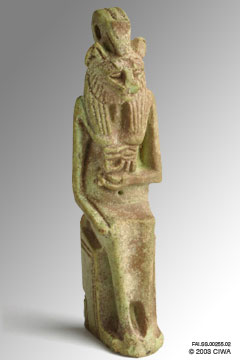Faience amulet of Bastet, c. 750 BC.

Links to other views:⇒ Larger View⇒ Back if scripting is off, click the ⇒ instead. Links to others from Dynasty 23Duamutef trapping for Baket, Dyn. 23Hapy trapping for Baket, Dyn. 23 Imhotep, vizier and architect of King Djoser Imsety trapping for Baket, Dyn. 23 Inscription trapping for Baket, Dyn. 23 Inscription trapping for Baket, Dyn. 23 Isis trapping for Baket, Dyn. 23 Isis trapping for Baket, Dyn. 23 Nephtis trapping for Baket, Dyn. 23 Qebesenuef trapping for Baket, Dyn. 23 Scarab trapping for Baket, Dyn. 23 Udjat eye amulet-pendant, Dyn. 23 Udjat eye amulet-pendant, Dyn. 23 Links to others representing SakhmetAmulet-pendant of Sakhmet, Dyn. 22Bronze of Sakhmet seated, Dyn. 20-23 Bronze of Sakhmet seated, early Dyn. 18 Bronze statuette of Sakhmet, Dyn. 20 Sakhmet amulet pendant, Dyn. 18 Stone seal of King Mentuhetep II, Dyn. 11 Links to others of type PendantBronze stauros (cross) pendant, CopticGold pendant, Cyprus, 1400-1300 BC. Miniature head, Carthage, 400-300 BC. Sin (crescent) pendant, Iran, 1200 BC |
This green faience amulet represents the lion/cat goddess Bastet, seated. She wears the uraeus (now broken) atop her head and holds the Udjat (eye of Horus) in her left hand, close to her heart. The back-pillar bears a hieroglyphic inscription which reads “Bastet”. The workmanship suggests that the piece was made during the Third Intermediate Period, a time of economic and political instability and weakness at the end of Dynasty 23 (circa 750 BC). “The numerous amulets of maned lion-headed women which first appear in and are a feature of the Third Intermediate Period, walking and seated, with and without insignia, usually made of finely modeled glazed composition though occasionally of precious metal, lapis lazuli or sard, are among the most difficult to identify; even the few with inscriptions tend to give contradictory information. . . Grass-green glazed-composition goddess, holding a ‘wedjat-eye’ to her chest, the back-pillar names Bastet” (Andrews, 1994:33). Amulet Amulets are objects generally kept on the person that are believed to confer some benefit to the wearer. While turn of the century archeologist Flinders Petrie (1914) enraged that “the belief in the magic effect of inanimate objects on the course of events is one of the lower stages of the human mind in seeking for principles of natural action. . .”, he had to concede that the use of amulets, talismans, and charms is very ingrained in many cultures to the present day. Many of us use lucky pens and wear religious medals without believing literally in their powers to affect our lives. But we still use them. They help us muster the confidence we need in times of self doubt. They empower us to dare, to believe in ourselves, to heal ourselves. Egyptians may have felt the same way. They used amulets on themselves and on their dead. Egyptians also seem to have had a passion for jewelry, and amulets were a good excuse to wear more jewelry. Egyptians created an astonishing variety of amulets. The Dendera Amulets List, engraved on the thickness of a temple doorway, shows 104 different amulets for funerary use. The MacGregor Papyrus shows and names each one (Andrews 1994:7). Petrie described some 270 kinds of amulets in his 1914 monograph on the subject, and yet it was published before the excavation of many sites rich in amulets! He devised a classification system which, for all its flaws, is useful and still stands as no worse than any devised since to put order in that which defies classification: “The various ascertained meanings may be completely put in order under five great classes… (I) the amulets of Similars which are for influencing similar parts, or functions, or occurrences, for the wearer; (II) the amulets of Powers, for conferring powers and capacities, especially upon the dead; (III) the amulets of Property, which are entirely derived from the funeral offerings, and are thus peculiar to Egypt; (IV) the amulets for Protection, such as charms and curative amulets; (V) the figures of Gods, connected with the worship of the gods and their functions… Our classes then are here called amulets of Similars, or Homopoeic. The evolution of amulets follows a fairly logical path. The first amulets were natural objects such as shells, and symbolically charged body parts of animals, such as claws from birds of prey. Then, still in predynastic times, we find figurines of significant animals, such as the hippopotamus, falcon, and jackal. Through the Old Kingdom, there was a development of animal forms with increasing levels of sophistication, and by the middle of the Old Kingdom we find the abstract symbolic subjects (such as the Ankh (sign meaning “life”), the Udjat eye of Horus, the Djed pillar, and the scarab) which remain some of the most emblematic symbols of Egyptian culture. During the First Intermediate Period we find amulets representing human body parts (ear, tongue, hand, arm, phallus, leg, heart...). The Middle Kingdom expanded the whole range of objects and gave the scarab its final form. But despite this considerable repertoire, amulets representing major gods remained rare until the end of the New Kingdom, at which time they suddenly flourished, and became as a group the most prevalent type until the end of Dynastic history. (Andrews 1994) Bibliography (for this item)Andrews, Carol1994 Amulets of Ancient Egypt. University of Texas Press, Texas. (33,34) Bibliography (on Amulet)Andrews, Carol1994 Amulets of Ancient Egypt. University of Texas Press, Texas. Petrie, W.M. Flinders 1914 Amulets. Constable & Company, London, UK. |